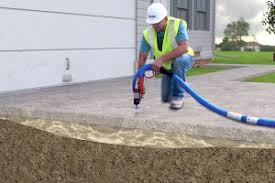What is Mudjacking?
Mudjacking is one of the best ways to repair concrete because it only takes a few hours to finish. Mudjacking is a way to lift asphalt slabs on sidewalks, patios, and driveways. It is a type of concrete leveling. In mudjacking, the slab is lifted back up to its original height by pumping cement slurry—usually a mixture of sand, water, and cement—under it through a hole. Mudjacking and concrete leveling professionals are the only ones who should do this job.

Fig: Mudjacking
Courtesy: masonrycontractor.com
Characteristics of Mudjacking:
- Mud is pumped underneath sinking concrete surfaces to raise them. Mud is pushed through holes near the surface of the concrete by a hydraulic pump. The diameter of the holes is between 1.5 feet and 2.5 feet.
- The mud used in the process is made by mixing Portland cement, topsoil, and water. The mud is then pumped through a hose into holes near the surface of the set concrete.
- The pumped slurry fills the empty spaces under the structure and hardens to make a strong base.
- Mud jacking is a quick way to lift sunken concrete surfaces. This process doesn’t fix the structure of the surface or make it last longer.
- In the following cases, mudjacking is the best option:
i) The concrete floor is leveled and still structurally sounds; it needs to be moved faster to where it should be.
ii) The customer doesn’t need to replace the concrete floor completely because they don’t have enough money or time, but they want a higher floor until it’s time for a full replacement.
How Does Mudjacking Work?
The process of mudjacking includes the following steps:
Step 1. Drilling Holes:
The first step is to drill 2-inch holes into the concrete. In most cases, the holes will be strategically positioned to raise the concrete slab. There is always more than one hole; typically, there are three to five. Those in charge of the repairs would place them at regular intervals, either in a predetermined pattern or at a constant distance from the concrete’s perimeter. You may rest assured that this will not just be a bunch of dots randomly placed.
Step 2. Slurry Lifting:
A nozzle is inserted into the holes to retrieve a liquid-like fluid from beneath the concrete. The mud, however, is not mud at all but rather something else that only resembles mud but is not sticky. The building industry calls this material “slurry” because of its viscosity. To make slurry, combine Portland cement, topsoil, and water into a pump, and the slurry elevates the concrete surface and fills all the ground’s holes and crevices. When it dries, it forms a solid base.
Step 3. Finishing Touches:
After pumping the slurry under all the concrete slabs that need to be raised, the crew will double-check that everything is back in its original position and slope. Once the concrete has been repaired, the 2-inch holes drilled into it will be smoothed out. There will be visible fresh concrete rings where the repair was made. When exposed to dirt, weather, and water, they might gradually lose their bright color and become less noticeable.
Advantages of Mudjacking:
- The cost of mud jacking is cheaper than removing the entire concrete surface and installing fresh concrete.
- Since mud jacking involves restoring and reusing rather than demolishing, producing extra garbage, and beginning afresh, it is a more environmentally friendly option.
- Mud jacking is faster than removing and replacing concrete. Most tasks can be finished in a full day or a half.
- The mud-jacking procedure is much less intrusive and noisy than a complete replacement. A complete replacement would necessitate larger, noisier machinery and a lot of mess on your land. Not to mention that you must avoid the work zones and may not have access to some areas of your property for a period.
Disadvantages of Mudjacking:
- During the mudjacking process, there is a chance of damage to a concrete surface covered with tile or any other kind of finish.
- Cracks on the surface of the concrete cannot be fixed by mudjacking. It can only fill in the cracks and eliminate things that could cause people to trip.
Conclusion:
Mudjacking is a good way to fix foundations that have been damaged by shifting or settling. Mudjacking is one of the most popular ways to fix a foundation because it is quick and cheap. But mudjacking can only fix a foundation properly if the right tools and materials are used. Mudjacking can be used for fixing broken sidewalks, uneven patios, sunken porches, sinking parking lots, and more.
References:
1. “What Is Mudjacking? | Concrete Leveling.” Angi, 4 Nov. 2021, www.angi.com/articles/what-is-mudjacking.htm.
2. Gambrick. “What Is Mud Jacking?” Modern Design, 20 Sept. 2022, gambrick.com/what-is-mud-jacking.
3. “Mudjacking in Construction | Concrete Repair Tips.” Mudjacking in Construction | Concrete Repair Tips, www.constructioncost.co/mud-jacking.html. Accessed 30 Oct. 2022.
4. “Slab Jacking – Lifting Concrete Slabs – Concrete Network.” Slab Jacking – Lifting Concrete Slabs – Concrete Network, www.concretenetwork.com/concrete/slab_jacking/what_is_slab_jacking.htm. Accessed 30 Oct. 2022.
5. Brown, David. “Mudjacking: Everything You Need to Know.” Foundation Professionals of Florida, 27 Mar. 2021, www.foundationprosfl.com/mudjacking-everything-you-need-to-know.
6. CementConcrete. “Mud Jacking: Meaning, Process, Foundation, Cost| Polyjacking Vs Mudjacking Concrete – Cement Concrete.” Cement Concrete, 11 Nov. 2021, cementconcrete.org/structural/foundation-design/mud-jacking-polyjacking/3383.
If you have a query, you can ask a question here.


